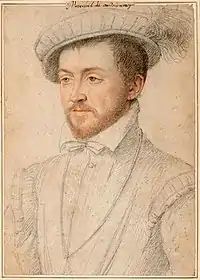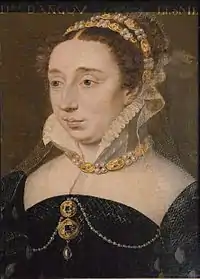François de Montmorency
François de Montmorency, Duc de Montmorency KG (17 July 1530 – 6 May 1579) was a French soldier, diplomat and peer who served as governor of Paris. He was Duke of Montmorency, Count of Dammartin, Baron of Châteaubriant and Lord of L'Isle-Adam, Grand Master of France, and Marshal of France.[1]

Biography

François was the eldest son of Anne, constable of France,[2] and Madeleine of Savoy. He accompanied the King to the border of Germany and was present at the capture of Damvillers and of Ivoy in 1552. He took part in the heroic resistance of the town of Thérouanne against the attacks of the troops of Charles V: finally, it had to fall and he was made prisoner on 30 May 1553.[3]
On his return from captivity, he was knighted on Michaelmas and was provided with the Government of Paris and the Île-de-France (1556).[4] He was sent to the aid of the Pope Paul IV and retoke with the Spanish the port of Ostia and some other places around Rome. He took part in the Battle of Saint-Quentin on 10 August 1557, defended Picardy against the Spanish and helped in the siege of Calais, in 1558. The King sent him with an embassy to Elizabeth I of England to get her agreement to the Treaty of Cateau-Cambrésis, with Montmorency acting as a signatory.[5] With the death of the King Henri II, he had to yield the title of Grand Master, inherited from his father, to the Duke of Guise. The King then gave him the position of Marshal of France in 1559.

François married against his will in 1557 to Diane de France, natural daughter of Henry II.[6]
In 1560, François attended the Estates General, held in Orléans. He remained loyal to the crown in the first French war of religion, fighting in the battle of Dreux in 1562, and the recapture of Le Havre in 1563.
The 16th-century French historian Brantôme wrote: "Now, besides the fact that Monsieur de Montmorency was brave, he was a wise and shrewd captain and a strong politician, and for this, the King [Charles IX], when he went to tour his kingdom [in 1564], left him Governor of the Île de France and [Governor of] Paris, where he showed his wisdom and good leadership, because, having found the people of Paris, just emerged from civil war, still a great enemy of the Huguenots, mutinous, seditious, shaking and boiling all over, with mutiny and envy, always spilling blood, ... he rendered them supple and easy to handle like a buckskin glove from Vendôme, with which the King was greatly satisfied."[7]
In the second of the wars of religion, he took part in the Battle of Saint-Denis (10 November 1567) in which his father died.
Once he became Duke, François continued the House of Montmorency's rivalry with that of the House of Guise. This rivalry did not cease but increased. In 1570, he had the very difficult task to make the Peace of Saint-Germain accepted in Paris. In 1572, he was sent to Queen Elizabeth I of England to get her to sign an alliance with France. It was on this occasion that he was created an Honorary Knight of the Order of the Garter. In France, François was more unpopular than ever. His incapacity to control the Parisian mutineers finally meant he had to give up his post of governor of the city. He left the city a few days before the St. Bartholomew's Day massacre (23–24 August 1572). It was he who discreetly took down the corpse of Gaspard de Coligny, his cousin, from the gallows of Montfaucon, where he was hanging.
In 1574, Charles IX appointed him to the court, but the hatred was so strong between him and the Duke of Guise, he had to leave again. Not having anything more to lose, he took part in the plot of Malcontents, the "Third Party" with the Duke of Alençon, but he was stopped and locked up in the Bastille with the Marshal of Cossé-Brissac.[8] He was released in April 1575,[8] and the King recognized his innocence by letters, recorded at the Parliament. He died in the Château d'Écouen on 6 May 1579.
References
- Vindry 1901, p. 349.
- Ward, Prothero & Leathes 1934, p. table 27.
- Broomhall 2019, p. 109.
- Holt 2002, p. 10.
- Holt 2002, p. 23.
- Lanza 2007, p. 29.
- Mémoires de M. Pierre de Bourdeille, Seigneur de Brantôme, 1735, second volume, p. 129: Or outre que monsieur de Montmorency fut valeureux, il étoit sage et a[d]visé capitaine et fort politique, et pour ce le Roi, quand il s'en alla faire le tour de son Royaume, il le laissa gouverneur de l'isle de France et de Paris, là il montra bien sa sagesse et bonne conduite; car ayant rouvé ce peuple de Paris, qui de frais ne sortoit que la guerre civile, encore grand ennemi des Huguenots, mutin, seditieux, croullant, et bouillant tout de mutination et d'envie dépandre toujours du sang, ... Il le rendit souple et maniable comme un gant chevrotin de Vendôme, dont le Roy en eut très-grand contentement....
- Knecht 2014, p. xxviii.
Sources
- Broomhall, Susan (2019). "Corresponding romances: Henri II and the last campaigns of the Italian Wars". In Downes, Stephanie; Lynch, Andrew; O’Loughlin, Katrina (eds.). Writing War in Britain and France, 1370-1854: A History of Emotions. Routledge.
- Holt, Mack P. (2002). The Duke of Anjou and the Politique Struggle During the Wars of Religion. Cambridge University Press.
- Knecht, R. J. (2014). The French Wars of Religion 1559-1598 (3rd ed.). Routledge.
- Lanza, Janine M (2007). From Wives to Widows in Early Modern Paris: Gender, Economy, and Law. Ashgate Publishing.
- Vindry, Fleury (1901). Dictionnaire de l'état-major français au XVIe siècle (in French). Castanet. p. 349.
- Ward, A.W.; Prothero, G.W.; Leathes, Stanley, eds. (1934). The Cambridge Modern History. Cambridge University Press.